If there’s anyone who walks the functional hypertrophy talk, it is Fabio Zonin. Not only has he competed at the highest level in natural bodybuilding and powerlifting, he was the first Italian to best the Beast Tamer Challenge and become a StrongFirst Certified Master Instructor. Plus, he was a Master Teacher for the Italian Federation of Fitness for almost two decades. Fabio has trained many athletes at national and international levels in natural bodybuilding, powerlifting, rugby, MMA, boxing, and other sports.
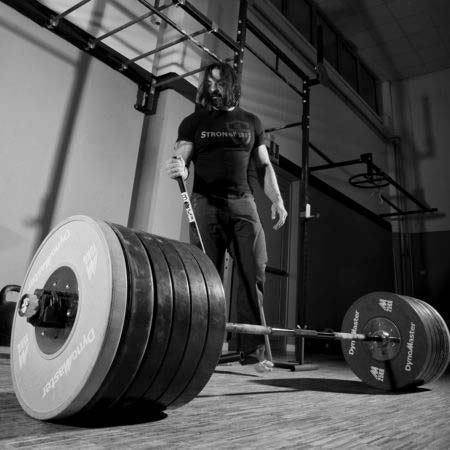
As a coach, Fabio has always looked for better ways to produce results while avoiding the common pitfalls of traditional programming. This ongoing quest for innovation led him to create Built Strong, a unique program for hypertrophy based on Plan Strong™ that delivers impressive results. In this interview, Fabio reveals the limitations of traditional mass-building programs, the importance of total-body balance, and the power of decoupling volume and intensity.
You have used various successful approaches to building muscle in the past. Why reinvent the wheel and change what had worked before?
I started experimenting with Soviet strength training methods with a goal of adding muscle mass without compromising other attributes. Bodybuilders usually train to failure; then are sore for the next few days—that’s why they split their sessions to focus on different body parts each day. And while Pavel adapted strength methodology to get people stronger, I turned my attention to strength with hypertrophy. I wondered: “What if there’s a way to train where you don’t get so sore, don’t affect your movement patterns, and can still reach your goals?”
Once you’d had the idea, where did you go from there?
I’m now on version twelve (possibly more by the time of publication) that I tested on myself and others over a two-plus year refining process. A long time ago, I resolved to never offer a plan to someone before I’d rigorously tested and refined it myself—I’m always the guinea pig because I want to understand how it works, gather sufficient data, and make sure it’s safe and effective for others. It was following a powerlifting injury that I decided to retake the bodybuilding stage. In preparation, I adopted the basic principles that would eventually become Built Strong—training movement patterns instead of isolated muscles and not training to failure. It worked (and I took second place).
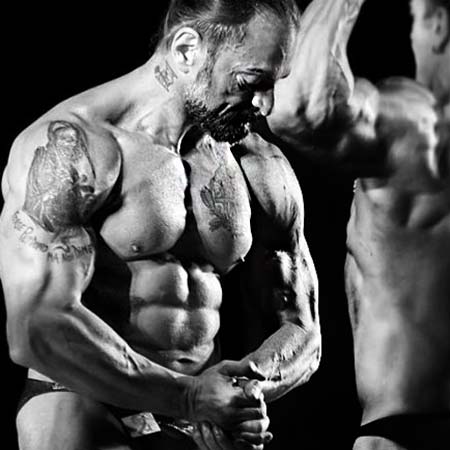
Knowing that I was onto something different, I added Plan Strong™ principles to further refine the strength hypertrophy program—and Built Strong was born. The owner of the gym where I train asked me what I was doing, and by this time, I was confident enough in the program to share it with him. He ended up winning both major Italian federation championships—one of which does not test for performance-enhancing drugs—while competing naturally.
I’ve had high level athletes test the hypertrophy plan with significant success—increased mass without compromising their performance.
My training partner also achieved his desired results, as has a regional StrongFirst Accredited Gym member—a lady hairdresser who just wanted to be stronger and look good. That was definitive proof that this program isn’t just for bodybuilders—it’s for anybody who wants to add a little size, sculpt their frame, and be stronger.
So whether you want the competitive edge from solid and strong muscle mass while maintaining movement quality—that neither takes too much time away from sport specific training to build nor leaves you sore for days afterwards—or perhaps you just want to look a certain way: this plan can be adapted for all of these goals and more.
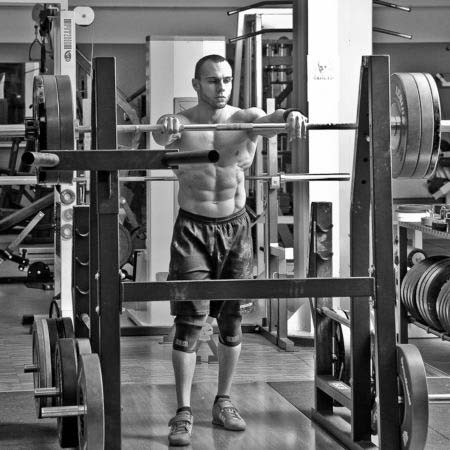
What are the main principles that make your Built Strong hypertrophy program different?
The first is that there’s more volume than in a traditional Western training plan, without having people train to failure. There are a couple of reasons for this. One is that training sessions should be treated as practice, not testing or competition—you don’t want to push yourself as far as you can go with a maximal effort. That’s why the rep ranges are always less than the maximum that you could do with a given weight. Combined with generous rest periods, this means you can keep perfect form and accumulate sufficient volume to stimulate hypertrophy, without going too far.
For example: Say I gave you a weight you could press six times before exhaustion and asked you to do four sets of six reps with a short break between sets. You might get those six reps in your first set, but in the second, it may be four, then three, then two—and you’d be straining yourself each time and probably compromising your form. Instead, if I asked you to do three clean reps with a longer break between each set, you could do six or eight sets without your technique deteriorating. When you keep some reps in the bank, you maintain quality and perform more volume overall.
Then we must consider the relationship between intensity and volume. In a traditional Western strength plan, you’d increase intensity every week in a linear fashion, and have to decrease volume as you did so, until you peak with a new one-rep max. So, if you were working on your deadlift (assuming a max of 500 pounds), you may start with 5 sets of 5 at 300 and add 25 pounds each successive week until it gets too heavy to still do 5 times 5. Now you go to 3 sets of 3, then 2 sets of 2. So, volume and intensity are generally inversely related.

In our new approach, we’ve de-coupled volume and intensity. You will use light, medium, and heavy weights but will stay around 70 percent of your one-rep max on average.
What varies a lot is the volume. We change it sharply, session to session, week to week, and month to month. Imagine that you did 300 squat reps in a month. The next you might do 240 or less, and the one after that, 360 or more. In a Western plan, if you were doing say 400 reps in a month, it would usually be split into 100 reps per week. Not so with our program—you’ll do 140 reps in week one, 60 in week two, and so on. By waving the volume, you force your body to adapt to abrupt changes.
What are the physiological differences between this plan and traditional hypertrophy training?
With direct muscle work or body part training, you take everything you can from a muscle in each session, then have to emphasize another one the next day because the first is too sore and stiff. That doesn’t work for athletes who use their entire body to practice or play their sport and neither is it practical in everyday life. I wanted to find a way to produce hypertrophy without sacrificing movement quality, performance, or overall health. So, I reviewed the science on what causes muscles to grow. One factor is high volume training. Traditional bodybuilders shift a lot of their attention to hypertrophy in the slower type I muscle fibers, sarcoplasm, and capillaries. When you do this—particularly in bodybuilding—you get what could be called cosmetic hypertrophy. The muscles are bigger but they’re not necessarily much stronger. I realized that we could get both strength and size by targeting the strong and fast 2x and 2a muscle fibers and other structural elements, including the fascia, ligaments, tendons, sarcoplasmic fluid, mitochondria, and so on. I also focused on the part of the muscle that’s related to strength and then tinkered with volume and intensity to prompt muscle growth and strengthening of the connective tissues. Next, I considered symmetry. This is cosmetic in bodybuilding, but if you’re a strong and functional human being, then balance is important to you too. Form is directly related to function.
| Built Strong | Traditional Bodybuilding |
| Sets are performed with a buffer (some reps are always “left in the tank”) | Sets are carried to failure |
| Perfect technique is always maintained, and safety always ensured | Technique deteriorates as fatigue sets in, which may lead to higher risk of injury |
| Keeps one fresh and pain free the days that follow the training sessions | Makes one feel fatigued and sore the days that follow the training sessions |
| Focuses on movement patterns | Focuses on isolating single muscles |
| Preserves movement quality, flexibility, and improves posture | Does not necessarily preserve movement quality, flexibility, and good posture |
| Based on algorithms which ensure a precise adjustment and customization of the training loads | Most often instinctive, leading to more risk of under- or over-training |
| Increases one’s strength while building muscle | Doesn’t necessarily make one stronger |
| Requires minimalist equipment | Requires more sophisticated equipment, often including machines |
| Inconsistency among the duration of training sessions, with some very short and some very long. Not suitable for those with a limited and well-defined time to devote to training | The length of the training sessions is customizable; for those with a limited and well-defined time to devote to training |
What are the main challenges students have with this new methodology?
The variability in volume is unfamiliar to many people because they’ve always used more linear programming. Some sessions seem very short and light to them, while others seem very long and heavy. For someone who goes to the gym at the same time every day and is used to training for a certain duration, it takes a while to get used to doing 15 or 20 minutes one day and an hour the next. But this isn’t a gimmick; it’s planned variability with a purpose. The key is to stick with it for the entire 8-12 weeks program and the results will come.
Next, bodybuilders are used to doing body part training because they go to failure and can’t emphasize the same muscle groups the next day. But with this hypertrophy program, we train all major fundamental movement patterns to some degree. The emphasis changes but each element is always present. This provides balance in motion, strength, and appearance. While they’re skeptical at first, it gives bodybuilders the symmetrical appearance they want; as the better you move, the better you look. For everyone else, the plan delivers balanced, functional strength. If a fighter wants to do strength training twice a week, a bodybuilder wants to do six days, or if a regular person has three or four days available, this program can be adapted for them. Everyone who has tried it is moving better, is stronger, and has gained mass.
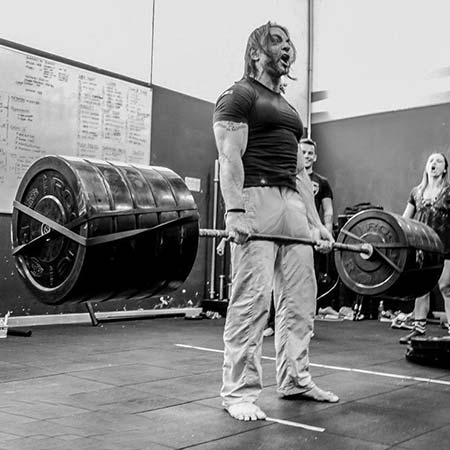
How can someone who’s primarily used to kettlebell training incorporate this program?
You can absolutely do the entire plan with kettlebells, with the addition of a pullups bar and double kettlebell for the squat, hinge, and some of the presses. But the best results will come if you use the three main modalities—kettlebells, barbells, and bodyweight—together. They all have unique benefits. Kettlebells, with their different center of mass, are perfect for unilateral work. Barbells allow for smaller adjustments and unlimited loading. And bodyweight training is always available, no matter where you are. If you can include the best of all three, then you’re set. To implement the plan as originally intended, all you need is a squat rack, kettlebells, a barbell, and some plates.
Learn more about programming for functional hypertrophy—to build muscle that is as strong as it looks—at our Built Strong online seminar, May 18-19, 2024.


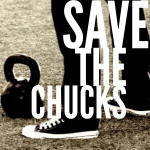

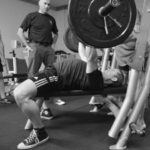


I would love to hear if anyone has done this with only KBs and what were the best substitutes for the barbell movements. Based on another article written by Fabio, does the below make the most sense?
Hip Hinge
Main lift: Romanian deadlift
Specialized Variety: Swing
Horizontal Press
Main Lift: KB/DB Bench press
Specialized Variety: Dip
Squat
Main Lift: Double KB front squat
Specialized Variety: Double KB front squat or Goblet squat
Horizontal Pull
Main Lift: One-arm row
Specialized Variety: Renegade Row
Hi,
“Hip Hinge
Main lift: Romanian deadlift
Specialized Variety: Swing”
I see the Romanian DL more as a specialized variety exercise. Also, the swing, as a ballistic exercise, is not the perfect fit within a plan that focuses on hypertrophy. It could be done on alternate days for conditioning/body fat control. I would go for deadlift (conventional or sumo) as the main lift and romanian DL as specialized variety. If you want to use kettlebells, what about the KB one-legged deadlift as specialized variety?
“Horizontal Press
Main Lift: KB/DB Bench press
Specialized Variety: Dip”
Looks good to me!
“Squat
Main Lift: Double KB front squat
Specialized Variety: Double KB front squat or Goblet squat”
Looks good to me. Or pistol as specialized variety.
“Horizontal Pull
Main Lift: One-arm row
Specialized Variety: Renegade Row”
Looks good to me.
I hope this helps.
+1 for ebook
More details wanted! YouTube series, articles, podcasts, anything.
We are definitely planning on organizing one in Europe.
Thank you for your interest, very much appreciated.
To join do i have to be going for ‘instructer’ or can be doing it for myself only?
I would love a book!
In fact I wish you all would sell the manuals also.
I understand wanting people to attend the seminars. But many cannot due to travel, work and financial constraints. But nearly everyone would be happy forking over the cash to purchase a book or manual. I believe it would be more lucrative in the long run also. I would happily spend more on a good book/e-book or manual that I can reference in the future.
I have to agree 100%. I’ve been waiting on an SFB book. I’ve read Naked Warrior and it is a great book but to have something more along the lines of what they teach for SFB would be great. I would definitely buy a Built Strong book as well.
I would definietely recommend an e book and manuals to help get that message out, like Simple and sinister, etc. But still keep the courses for the irreplaceable in-depth content.
+1 for a book :). Would be amazing!
Very Nice sir! this seems like its an excellent contribution to the SF methodology. Do you think build strong could fit into sessional plan, ie, hypertrophy cycle, strength cycle, Power/peaking cycle? I’ll have to keep an eye out for this to come to the East coast.
Thank you, Sir!
“Do you think build strong could fit into sessional plan, ie, hypertrophy cycle, strength cycle, Power/peaking cycle?”
Definitely!
Wow, that sounds like reasonable hypertrophy training. I love how SF tests and refines principle based protocols. Great way to combine the lessons from the past with methods from the present.
I attended PlanStrong and benefited from learning some critical concepts, such as the option of spacing out reps during the day and how to calculate optimal set reps, not just the programming itself. An ebook, after doing the seminars for a year or so and fine tuning the content with feedback from a high level audience, would be beneficial to those who want to improve their approach to training, even if they don’t fully use the optional training plan.
Another option to include might be how to combine strength and hypertrophy cycles. Pavel mentioned in some books and in the recent Joe Rogan podcast about a two week focus being optimal. I think that needs more clarification. How to program rotating strength, hypertrophy, and maybe a strength-endurance (complexes or KB) period over the course of a year would be interesting. I use a seasonal approach to switch up goals but I would be interested in a more scientific approach.
From a business perspective, the market for the seminars is more limited than a general public book version. It could be a perennial seller like S&S even if the volume is reduced after the first year or two whereas you are likely to want to keep developing new seminars as you are doing.
Thank you, Sir!
“Another option to include might be how to combine strength and hypertrophy cycles. Pavel mentioned in some books and in the recent Joe Rogan podcast about a two week focus being optimal. I think that needs more clarification. How to program rotating strength, hypertrophy, and maybe a strength-endurance (complexes or KB) period over the course of a year would be interesting. I use a seasonal approach to switch up goals but I would be interested in a more scientific approach.”
This will be covered during the seminar.
“From a business perspective, the market for the seminars is more limited than a general public book version. It could be a perennial seller like S&S even if the volume is reduced after the first year or two whereas you are likely to want to keep developing new seminars as you are doing.”
We are definitely considering a book or e-book. Of course a seminar dives much more into depth that what can be covered by a book and also participants may interact and ask specific questions, etc.
Nice article Fabio. Are you going to release somekinda program which uses these priciples in future. Maybe as a article or ebook. Keep up the good work.
I am not Fabio, but like PlanStrong, BuiltStrong is complex and you will be best served by attending the seminar if you wish to write your own programs or design programs for others. I went to PlanStrong _twice_ and I will attend BuiltStrong at least once.
Thank you, Sauli.
For now I will be teaching the Built Strong Seminar in August in Denver. And a manual will be provided to all participants. As far as for an ebook I am seriously considering it. Thank you again.
An eBook would be great…and a best seller!
Thank you, Brad!
definitely!
Hello Sir,
Will you be holding a seminar in Europe?
I will be looking forward to it after everything goes back to normal ( hopefully soon)
Stay safe!
I would buy an ebook in a heartbeat – and recommend it to everyone I know.